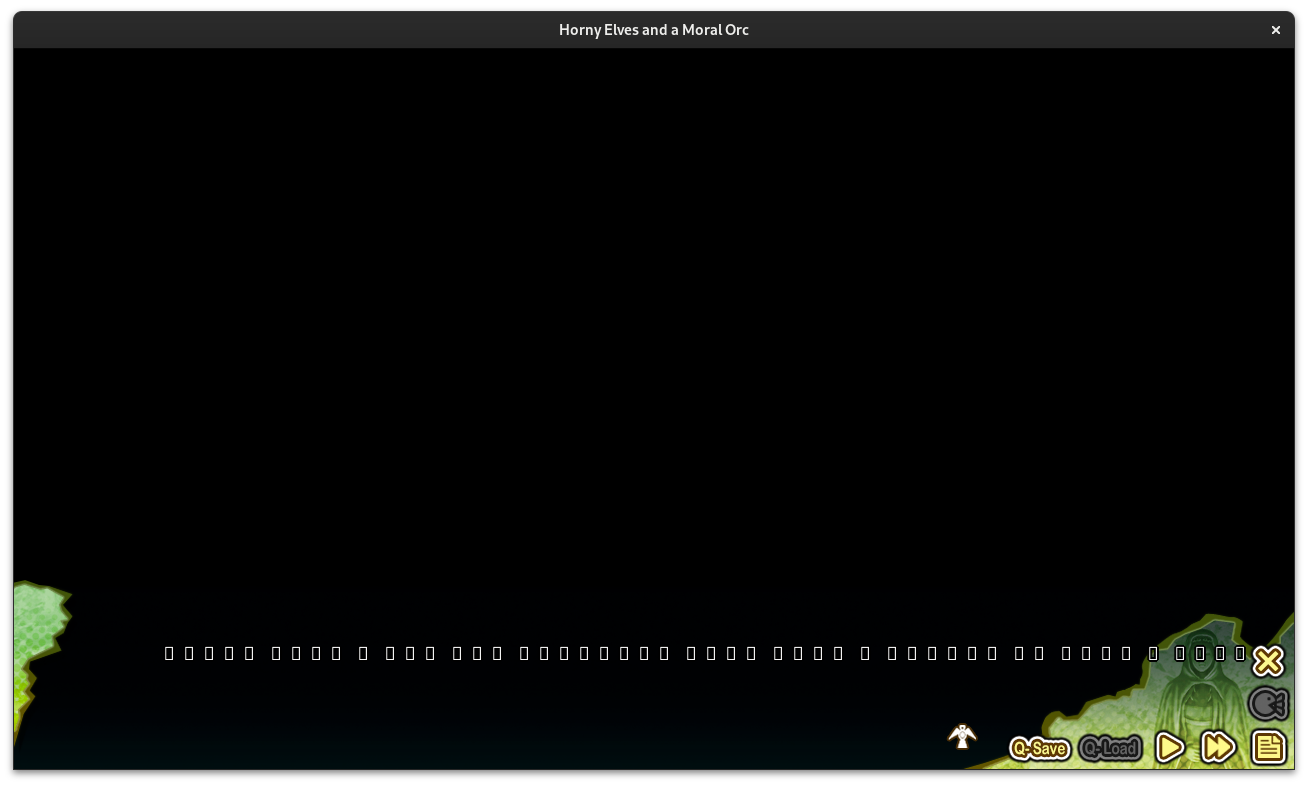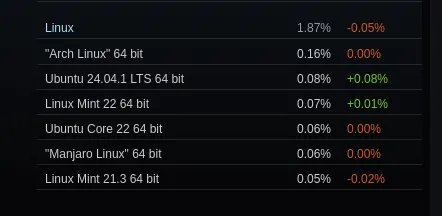For those who want a summary; it's been going okay, but could've gone better. I decided to space out my tinkering and keep going with life, since these days my life is not so bound to my desktop. (It's also possible some details weren't recorded quite right. Many search tabs were closed)
I've been aware of the impending death of W10 in October 2025, with fears that hackers will start taking over the OS at that time. My main reason for avoiding Linux was game support, but Valve has been handling that well.
I decided to set up a Linux Mint 21 drive, which at first was difficult because my first USB stick had corrupted sectors (took some time to determine that was the issue). Then, when I booted in...it didn't support my wi-fi (it claimed it did, then couldn't connect, even when pairing with my phone). My first plan was to set up a nice, isolated 500GB partition on my nvme SSD (a drive I'd mostly used to store games) for Linux, and have it refer to the NTFS partition for games. (I would later learn this doesn't work well, and Linux is optimized for ext4).
Then, I learned this NVME had an "MBR" partition table, and I still had to convert it to GPT. While there's several tools for this, they complained due to the placement of my partitions, not leaving enough space for the table. I tried moving the entire gaming partition 1MB to the right...and got the same error.
After deleting the (backed up) partition to finish GPT conversion, I learned two things. One, that it was actually complaining because when giving the converter the target Device, I had given it the "Device:" labeled in the Disk management, which was "/dev/nvmen0p1". Guess what the P stands for at the end? So, gentle tip: The "Device" is not the "device", it's the partition - and diskpart does not present the resulting error well. Second thing I learned was that Windows had somehow put some of its boot setup on the NVME back when I had installed it on my computer; so now Windows wouldn't boot. (I'll see if I can fix this later. Windows' fault, not Linux's)
The good news is, I had downloaded a copy of Mint 22 (1 up), and THIS got full wi-fi and audio support. A little strange I had to go so recent for basic old-hardware support, but it could've been something else odd going on. I installed Steam, got a cryptic error about 32-bit NVidia drivers I ignored, and with my library moved back (and fixing ownership through chown, something Steam thankfully provided a relatively clear error message on) it's been able to run a few test games!
Having my browser and some basics up, I can kick back on YouTube and tackle whichever pressing things I think of first. I don't have replacements for 2 or 3 Windows products I like, but overall the setup has gone well, and a few of my annoyances actually go to my USB drive store, and Windows. Overall, much better than a decade past when I last tried Linux.
To keep Windows as an option, I'm planning to run a Windows installer repair boot to my original drive; but am admittedly worried whatever caused it to install boot info to the NVME against my instructions last time will, once again, screw up Linux. I may also try seeing if GRUB can locate Windows and boot it successfully. I feel somewhat blind on the topic of setting up / fixing the OS bootup.
I can tell this process is much simpler if someone has only one drive, backs things up to an external device, and then installs cleanly. Only on that vein, I wouldn't mind recommending it to others. Still, that's only in part because Microsoft has steadily made things worse and worse on the Windows front. (And, of course, I'll still be using it for work)
EDIT on day 3:
It's still been rocky. I became a bit pinpoint-focused on Hitman 3/"WoA" as my testbed to verify gaming was working; as it was more demanding and had proton dependencies ready. I selected a mission, got into the loading screen, and...got a black screen on the level, before a crash to desktop. Interestingly, the system was pretty unresponsive during the crash. Checked ProtonDB, nothing familiar about the issues. Failing so early felt like a dead end for Linux Mint as a gaming system, especially as it was one of my favorite games.
I had mentioned in prior comments I had skipped Bazzite worrying it would be the equivalent of RGB lighting and mostly unnecessary for gaming. But, if it's their claim to fame, I may as well try it. I had partitioned the OS away from the /home folder where I had copied my backup Steam games, so I went ahead with the reinstall. The Fedora-based partition selector was not so clear about its errors/required fields, or good at suggesting defaults for /home, /boot, and /boot/efit mounting; I ended up looking up recommendations (200MB boot? etc) on another laptop. To be fair, it's probably a less common use case, but still worth highlighting this part could've been clearer.
Bazzite worked! It was quick to put up a working Steam install, and Hitman levels loaded great. It took some time getting used to the new OS layout, but I'm not strongly opposed to it - it's a bit tablet-like, which makes sense since the OS targets ROGAlly users as well. That, in itself, is something I can live with. Of note, I wasn't terribly offended by Windows 8's largely hated tile layout and lived with it for years. I did not even need to compile the Xbox One dongle controller driver from source, as I had from Mint - worked out of the box!
Some things that stood out to me as annoying: The distro obviously makes efforts to cut down on options/buttons to simplify the experience and avoid overwhelming people. The biggest place I saw this is the file explorer, which insists on keeping you out of "/" and hopes 90% of your interactions will be with Documents / Pictures / Music. Given how many drives I had to interact with, this felt pretty crippling. Even after auto-mounting old drives I'd like to fetch things from, it still didn't show them in Open File dialogs within apps.
Bazzite tries to rise above the package managers of other distros by running any other necessary OS in containers. I'm no container pro, I've used docker for my job at times, but I tried going ahead with documentation. Treating it as an Ubuntu or a Fedora install, I had an extremely hard time getting VeraCrypt (a familiar app from Windows) working; using official .deb downloads on the website, or the package managers that had it listed. When I did finally get it installed off COPR, the "distrobox-export" command documented to add the app to my "Applications" did no such thing, nor did it explain what kind of filesystem entry it was trying to create.
As of yet, I still don't actually know where Bazzite's list of Applications is physically located, even after running some "find -iname" / locate commands. This might be nice to get to because the right-click menu on each one is sparse (again, simplified for users), and doesn't let me customize a few .desktop files not launching how I want them to. (A long time ago, something that really bothered me was Windows calling Steam's taskbar entry "Steam Runtime Helper" with no known way for me to fix it. But for Linux to also seemingly lock me out of solutions feels frustrating)
Some other things became worse. I set certain preferred keyboard shortcuts for window management, and Bazzite overwrote them to defaults - MULTIPLE times. That really set me off. When in the Activity View, many of the GUI apps did not have close buttons. I'm practiced with using tapping WIN+1 multiple times to go to the "third open Firefox window" - this is something apparently not supported on Linux, and I can't understand why. The OS takes a long time to recover from sleep mode, and needs ~10 seconds to re-discover my mouse. A few times, I came back to find the visuals garbled from some sort of display driver failure.
And, while Bazzite was very very good with games, as we all know falling just short of what we're used to niggles at our senses. Helldivers 2 worked - but a white-bar border at the edge only went away after tweaking launch options from ProtonDB. I launched Dead by Daylight, and while everything was visually fine, there was notable input lag, most visible on the game's reflex-based "Skill checks". I play a lot of games, and had gotten VERY used to "Install > Play > Done", so thinking about being so unsure on every game purchase worried me.
I have a number of small indie games that don't receive Steam's attention - often coming in from the web browser as .zip files with an EXE somewhere at their root. It's common for me to only spend less than 30 minutes downloading, trying it out, and maybe commenting on the creator's page. This is not a good workflow for Linux, given that launchers like Lutris make you fill out a long form with the position and title of the app before you can launch it - and give no immediate feedback or log output towards its launch failures.
I did research some of the many things annoying me, but of course Bazzite is still a niche offering and I was unsure at times whether to expand my searches to, eg "fedora disable screen anchors" or "gnome disable screen anchors". Often, I guessed I was the first person getting an issue.
When browsing the web, handling basic communications, even some games, I'm kind of comfortable with Bazzite. It's very very possible that a number of these issues would go away with some time and practice. But, I'm at an age where time is at a premium and it's VERY valuable to get a number of things "just working" without much concern. For those reasons, I'm definitely strongly considering going back to Windows.
I really hesitate to blame the strong array of choice for linux distros here - it's highly possible some comment will shout "Try XXXdistro!" and that would be the one where I'd magically run into zero problems, and all UI annoyances are things I could configure. But, getting that right so quickly seems unlikely. I may have shot myself in the foot with Bazzite, but I knew I wanted gaming as a focus, while as a consequence I got a lot of things locked down - to the point I couldn't even find configuration to tweak the things most breaking my workflow.

